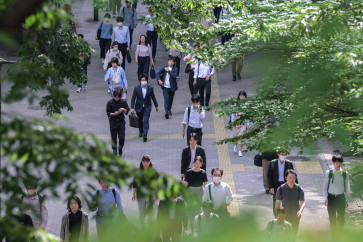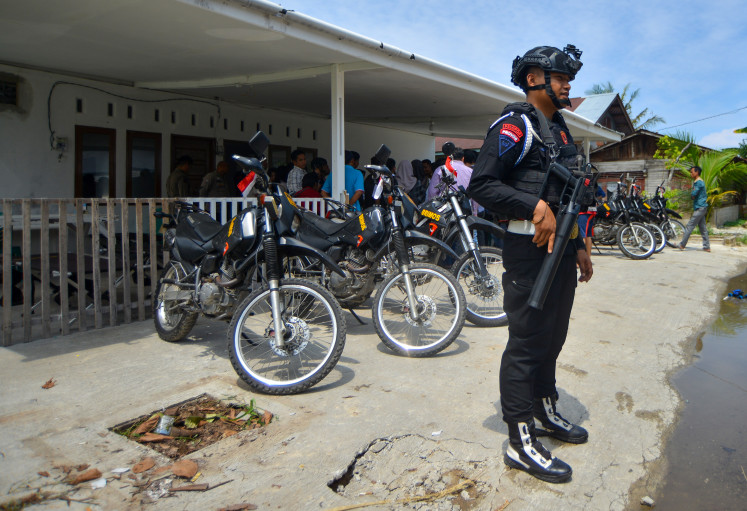Popular Reads
Top Results
Can't find what you're looking for?
View all search resultsPopular Reads
Top Results
Can't find what you're looking for?
View all search resultsReclamation, industries worsen coastal erosion
Land shield: An aerial photo taken on June 16 shows forests planted as part of a greenery campaign in Tegal on the northern shore of Central Java
Change text size
Gift Premium Articles
to Anyone
L
and shield: An aerial photo taken on June 16 shows forests planted as part of a greenery campaign in Tegal on the northern shore of Central Java. A concrete embankment has been built in the area to prevent land erosion.(Antara/Oky Lukmansyah)
With Indonesia losing large parts of its coastal areas to coastal erosion, scientists are citing coastal development and unsustainable economic activity as the main causes of the occurrence of the natural process.
Coastal erosion is a natural phenomenon occurring in coastal areas where land along the coastline is displaced due to waves, tides, currents and wind, among other factors. In ideal conditions, such land is replaced by the same amount of sediment eroded from other areas in what is called accretion.
However, this natural process is not occurring in large parts of the country.
According to a study from the Maritime Affairs and Fisheries Ministry, the country loses around 1,950 hectares of coastal area annually due to erosion, while only gaining around 895 ha from coastal sedimentation. In the last 15 years, the country has lost 29,261 ha of coastal area.
A researcher with the Center of Oceanography Research at the government-sanctioned Indonesian Institute of Sciences (LIPI), Wahyu Budi Setiawan, said any significant human-made changes to coastal areas could result in beach erosion.
“For example, if we construct a sea dike or any structures jutting out to the sea, it might trigger a higher rate of erosion as it affects the water circulation around the coastal area,” Wahyu told The Jakarta Post recently.
The Maritime Affairs and Fishery Ministry’s head of coastal disaster mitigation, Abdul Muhari, said: “In theory, the construction of a [hard] structure extending to the sea will affect areas on either side of the structure. It will cause great erosion on one side, while also causing heavy sedimentation on the other.”
This type of erosion can be observed in Demak, Central Java, the western coast of which has been eroding for the past 20 years. Abdul said the total amount of eroded coastal area there was equal the size of two to three soccer fields.
Experts say that erosion in the area, considered among the worst in the country, is due to the construction of ports and an industrial complex on reclaimed land near Bedono, Rejosari and Timbulsloko, villages in Central Java.
In images from 2002 obtained through Google Earth, erosion is seen occurring during construction on reclaimed land west of the villages. Images from 10 years later show nearby villages completely surrounded by seawater.
It is believed that the reclaimed land disrupted the natural process of sedimentation, hence the erosion.
The development of fish ponds by local residents in the area further exacerbated the environmental problem. The residents had cut down mangrove trees to build the ponds, perhaps not knowing how important a role the mangroves played in protecting the ecosystem.
The three villages also faced land subsidence problems caused by nearby groundwater extraction for industrial purposes. The villages are located several kilometers from the Terboyo Industrial Complex, which is believed to have used a significant amount of groundwater.
“If we don’t do anything in the area, we estimate that the three villages will sink into the sea in 10 years,” Abdul said.
This problem is not unique to Demak. With large-scale urbanization, the entire northern coast of Java Island is prone to coastal erosion, said Bandung Institute of Technology meteorology researcher Armi Susandi.
According to a study by the Public Works and Housing Ministry in 2001, about 48 percent of the population of Java lived on the northern side of the island. A number of populated cities are also located on or near the northern coast, including Jakarta and Semarang in Central Java.
Scientists predict that Jakarta will be submerged by water in less than a decade due to the over-exploitation of groundwater and lack of green spaces to absorb water. The city’s soil is made up of alluvium, or sediment, deposited by rivers, making the nation’s capital susceptible to erosion.
The causes of erosion vary depending on the region. In Southeast Sulawesi, for example, rampant mining has caused heavy coastal erosion on islands in the northern part of the province. At Siontapina Beach on Buton Island, there were reports of erosion as a result of illegal sand mining.
“Large-scale sand mining causes coastal erosion, as the sedimentation materials used to recover eroded areas are removed,” Armi said.










